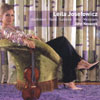Leila Josefowicz – Violin Sonatas
Imaginative programming hampered by occasionally uneven playing
View record and artist detailsRecord and Artist Details
Composer or Director: Johannes Brahms, Ludwig van Beethoven, Maurice Ravel, Mark Grey, Esa-Pekka Salonen, Olivier Messiaen
Genre:
Chamber
Label: Warner Classics
Magazine Review Date: 7/2005
Media Format: CD or Download
Media Runtime: 86
Mastering:
Stereo
DDD
Catalogue Number: 2564 61948-2

Tracks:
| Composition | Artist Credit |
|---|---|
| Thème et variations |
Olivier Messiaen, Composer
John Novacek, Piano Leila Josefowicz, Violin Olivier Messiaen, Composer |
| Sonata for Violin and Piano |
Maurice Ravel, Composer
John Novacek, Piano Leila Josefowicz, Violin Maurice Ravel, Composer |
| San Andreas Suite |
Mark Grey, Composer
Leila Josefowicz, Violin Mark Grey, Composer |
| Lachen verlernt |
Esa-Pekka Salonen, Composer
Esa-Pekka Salonen, Composer Leila Josefowicz, Violin |
| Sonata for Violin and Piano No. 10 |
Ludwig van Beethoven, Composer
John Novacek, Piano Leila Josefowicz, Violin Ludwig van Beethoven, Composer |
| Scherzo, 'FAE Sonata' |
Johannes Brahms, Composer
Johannes Brahms, Composer John Novacek, Piano Leila Josefowicz, Violin |
Author: Rob Cowan
Putting aside for a moment the wisdom (or lack of it) in programming these works together, Leila Josefowicz and John Novacek make for an absorbing if not always ideally balanced musical partnership. Messiaen’s early Theme and Variations mightn’t be entirely characteristic but its colours have an unmistakable radiance and Josefowicz grants them the benefit of some bright, nicely shaded playing. Novacek is at his best in the more assertive variations and while Josefowicz transfers from a cloister to a smoky lounge stool at the beginning of Ravel’s Sonata, Novacek is a bit too fussy for my taste, even within the first few bars. Then again, he has an attentive ear (the ‘blues’ of the second movement has some humorous, and occasionally delicate, gestures) and the finale goes with a real swing.
In the Beethoven Sonata I was again a little too aware of Novacek’s presence (and why such long pauses in the Scherzo?) though the theme-and-variations finale works well, with some sensitive playing both singly and in ensemble. In the case of Brahms’s passionate Scherzo Novacek’s prominence may well be the fault of the recorded balance; also Josefowicz doesn’t project as forcefully as she might have done. But what makes the programme worth considering are the solo pieces (both are world premiere recordings) and the expert way Josefowicz negotiates them. Salonen’s Lachen verlernt (‘Laughing Unlearnt’) is named after a movement from Schoenberg’s Pierrot lunaire in which the narrator declares she has unlearnt the skill of laughing and begs Pierrot, the ‘horse-doctor to the soul’, to give it back to her. In all essentials this is a chaconne which climaxes with frenetic insistence and provides plenty of opportunities both for display (towards the end of the piece) and subtler shading. Mark Grey sees his San Andreas Suite as ‘nodding to the vast array of music that weaves into [his native California’s] cultural fabric’. It’s simpler music than Salonen’s, more along the lines of, say, Adams, and a good expressive vehicle, too.
So, interesting new pieces and a recital that I would have been pleased to attend ‘on the night’. But for repeated listening? Not really consistent enough for that. And do collectors really go for this sort of mixed recital; or would they rather stay with same-composer (or at least same-period) programmes and enjoy the option of making up their own, custom-built mixes of ‘old’ and ‘modern’? A cue for some correspondence, perhaps…
In the Beethoven Sonata I was again a little too aware of Novacek’s presence (and why such long pauses in the Scherzo?) though the theme-and-variations finale works well, with some sensitive playing both singly and in ensemble. In the case of Brahms’s passionate Scherzo Novacek’s prominence may well be the fault of the recorded balance; also Josefowicz doesn’t project as forcefully as she might have done. But what makes the programme worth considering are the solo pieces (both are world premiere recordings) and the expert way Josefowicz negotiates them. Salonen’s Lachen verlernt (‘Laughing Unlearnt’) is named after a movement from Schoenberg’s Pierrot lunaire in which the narrator declares she has unlearnt the skill of laughing and begs Pierrot, the ‘horse-doctor to the soul’, to give it back to her. In all essentials this is a chaconne which climaxes with frenetic insistence and provides plenty of opportunities both for display (towards the end of the piece) and subtler shading. Mark Grey sees his San Andreas Suite as ‘nodding to the vast array of music that weaves into [his native California’s] cultural fabric’. It’s simpler music than Salonen’s, more along the lines of, say, Adams, and a good expressive vehicle, too.
So, interesting new pieces and a recital that I would have been pleased to attend ‘on the night’. But for repeated listening? Not really consistent enough for that. And do collectors really go for this sort of mixed recital; or would they rather stay with same-composer (or at least same-period) programmes and enjoy the option of making up their own, custom-built mixes of ‘old’ and ‘modern’? A cue for some correspondence, perhaps…
Discover the world's largest classical music catalogue with Presto Music.

Gramophone Digital Club
- Digital Edition
- Digital Archive
- Reviews Database
- Full website access
From £8.75 / month
Subscribe
Gramophone Full Club
- Print Edition
- Digital Edition
- Digital Archive
- Reviews Database
- Full website access
From £11.00 / month
Subscribe
If you are a library, university or other organisation that would be interested in an institutional subscription to Gramophone please click here for further information.




